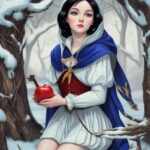Step into a world where magic blooms amidst the shadows of reality, where adventure awaits beyond the realm of imagination. For over two decades, J.K. Rowling’s spellbinding tale, “Harry Potter and the Sorcerer’s Stone,” has captivated millions, leaving an indelible mark on both young and mature readers alike. In this captivating summary, we embark on a journey to explore the timeless charm of this iconic novel, unravelling the secrets, spells, and surprises that have turned the wizarding world into a globally celebrated phenomenon.
As we traverse through the pages of this beloved book, you’ll witness the birth of a young wizard, Harry Potter, on that fateful day when he discovers his extraordinary heritage, receives his admission letter to the prestigious Hogwarts School of Witchcraft and Wizardry, and embarks on a magical journey that defies imagination. Unveiling the vibrant characters, bewitching settings, and awe-inspiring adventures that await within, this summary seeks to rekindle the sense of wonder and fascination that Harry Potter has ignited in readers across the globe.
Hold tight, for an experience awaits that will ignite your imagination, awaken your sense of adventure, and forever leave an imprint on your heart. Let us embark on this extraordinary expedition together and uncover the bewitching secrets hidden within the pages of this unforgettable tale.
Harry Potter and the Philosopher’s Stone: Full Book Summary
Once upon a time, in a tiny town called Little Whinging, there lived a boy named Harry Potter. Harry was not an ordinary boy; he was special. However, he didn’t know how truly remarkable he was until a mysterious letter arrived, inviting him to study at Hogwarts School of Witchcraft and Wizardry.
Harry lived with his dreadful aunt, uncle, and cousin Dudley, who treated him cruelly and made him sleep in a tiny cupboard under the stairs. They never told him about his parents, Lily and James Potter, who both passed away when he was just a baby. Harry believed he was just an ordinary boy with a lightning-shaped scar on his forehead.
When his eleventh birthday arrived, Harry received numerous letters from Hogwarts, but his aunt and uncle hid them all. They were determined to keep him from learning the truth about his magical abilities. However, a giant named Hagrid, who worked at Hogwarts, swiftly found Harry and told him the astonishing news: he was a wizard!
Hagrid whisked Harry away to Diagon Alley, a magical shopping street hidden within the heart of London. There, Harry discovered a world he had never known existed. He purchased his school supplies: a wand from Ollivander’s Wand Shop, a cauldron from Potage’s Cauldron Shop, and a beautiful snowy owl named Hedwig from Eeylops Owl Emporium.
Finally, the day arrived for Harry to board the Hogwarts Express, a magical train that took young witches and wizards to school. On the train, Harry made his first friends, Hermione Granger and Ron Weasley. Hermione was a bright girl with bushy hair and an insatiable thirst for knowledge, while Ron came from a loving but poor family with a knack for Quidditch, a popular wizarding sport.
As they reached Hogwarts, the trio was enchanted by the sight of the magnificent castle. They were welcomed by the kind Headmaster, Albus Dumbledore, who informed them about the four Houses: Gryffindor, Hufflepuff, Ravenclaw, and Slytherin. These Houses played a crucial role in the school’s community, promoting unity and friendly competition.
Harry, Hermione, and Ron were sorted into Gryffindor House, known for its brave and daring students. They quickly settled into their dormitory and began their magical education, attending classes such as charms, potions, and transfiguration.
Harry soon discovered that his scar held a deeper significance. It was a result of an encounter with the Dark wizard Lord Voldemort, who had murdered his parents and tried to kill Harry himself. Somehow, Harry had survived, and Voldemort had vanished that night.
As the school year progressed, Harry encountered many adventures and mysteries. He found a mysterious mirror called the Mirror of Erised that showed the deepest desires of anyone who looked into it. Harry often saw himself surrounded by his late parents, longing for their love and affection.
Meanwhile, Harry, Hermione, and Ron stumbled upon a three-headed dog guarding a trapdoor. They suspected that something valuable and potentially dangerous lay beneath it. With the help of Hagrid, they learned about the Philosopher’s Stone, which possesses the power to grant immortality and turn any metal into gold.
Harry couldn’t shake the feeling that someone was trying to steal the Philosopher’s Stone. He and his friends began investigating, unravelling clues while avoiding the strict gaze of their Potions professor Severus Snape.
During their adventures, Harry discovered that Quirinus Quirrell, the seemingly harmless Defense Against the Dark Arts teacher, was actually working for Lord Voldemort. Quirrell had been the one trying to steal the Philosopher’s Stone under Dumbledore’s watchful eye.
In a powerful climax, Harry faced Quirrell, who revealed that Voldemort was living within him, hidden under a turban. Harry’s touch burned Quirrell’s skin, ultimately leading to Voldemort’s temporary defeat. Harry, weakened by the encounter, fell unconscious.
When he awoke in the school’s hospital wing, Harry learned that the Philosopher’s Stone had been destroyed, and Dumbledore assured him that Voldemort would never return in the same form again. Harry was celebrated as a hero, and his friends were proud of him.
As the school year drew to a close, Harry and his friends boarded the Hogwarts Express to return home. They bid farewell, promising to reunite the following year. Harry Potter, having discovered his untapped abilities and embraced his true identity, knew that more adventures awaited him at Hogwarts and beyond.
With the Philosopher’s Stone’s mystery solved and darkness momentarily vanquished, Harry Potter embarked on a journey that would define his life. Little did he know that Hogwarts would become his home, and he would face countless battles, friendships, and discoveries that would shape his destiny as the Boy Who Lived.
Harry Potter and the Philosopher’s Stone: Key Themes
Harry Potter and the Philosopher’s Stone, written by J.K. Rowling, follows the adventures of an 11-year-old boy named Harry Potter, who discovers that he is a wizard and is accepted into the Hogwarts School of Witchcraft and Wizardry. Here are three key themes of the book:
1. Identity and Belonging: At the beginning of the story, Harry is unaware of his magical heritage and is living with his abusive aunt and uncle. However, once he enters the wizarding world, he begins to experience a sense of belonging and discovers his true identity. This theme is evident throughout the book as Harry navigates his way through the challenges of being a newcomer in a magical society and ultimately finds his place among his friends and at Hogwarts.
2. Good versus Evil: Throughout the story, Harry learns about the dark wizard Lord Voldemort, who seeks to regain power and bring chaos to the wizarding world. The battle between good and evil is a central theme in the book, as Harry and his friends must confront various obstacles and dangers in order to prevent Lord Voldemort from gaining the Philosopher’s Stone. This theme highlights the importance of courage, friendship, and the fight against injustice.
3. Friendship and Loyalty: Harry quickly forms strong friendships with Ron Weasley and Hermione Granger, who play significant roles in his journey. The theme of friendship is portrayed as vital, as Harry relies on his friends’ support and guidance to overcome challenges. Loyalty is also emphasized, especially when Harry’s friends stand by him when others doubt his claims about Lord Voldemort’s return. These friendships not only provide emotional support but also become crucial in helping Harry face the tests and trials that lie ahead.
Overall, Harry Potter and the Philosopher’s Stone explores themes of identity, the battle between good and evil, and the importance of friendship and loyalty, captivating readers with its magical world and timeless messages.
Harry Potter and the Philosopher’s Stone: Characters
Harry Potter
The protagonist of the story, Harry is a young wizard with a lightning-shaped scar on his forehead. With messy black hair and round glasses, he is known for his courage and determination. Raised by his neglectful aunt and uncle, Harry discovers his magical abilities and embarks on a captivating journey at Hogwarts School of Witchcraft and Wizardry. Despite his fame within the wizarding world, Harry remains down-to-earth and loyal to his friends.

Hermione Granger
A brilliant and resourceful witch, Hermione is known for her bushy brown hair, large front teeth, and effortless intelligence. She quickly becomes Harry’s loyal friend and is always eager to help him solve mysteries and conquer challenges. With her extensive knowledge and knack for book-smarts, Hermione regularly saves the day with her quick thinking and magical prowess.
Ron Weasley
Harry’s best friend and the youngest of the Weasley clan, Ron is a tall and freckled wizard with fiery red hair. Though he may not match Hermione’s smarts, Ron brings humor and loyalty to the trio. His tendency to get himself into tricky situations adds a light-hearted touch to their adventures, making him a beloved and relatable character.
Albus Dumbledore
The wise and eccentric headmaster of Hogwarts, Dumbledore is a tall, thin man with a long white beard and twinkling blue eyes. As a skilled wizard, his guidance and mentorship play a vital role in Harry’s journey. Dumbledore is renowned for his magical abilities and his knack for finding wisdom in the most unexpected places.
Severus Snape
The mysterious and brooding Potions professor, Snape is a dark-haired wizard with a hooked nose and a perpetual scowl. Known for being cold and strict, Snape’s loyalties are constantly questioned throughout the story, leaving readers guessing until the very end. Despite his rough demeanor, he is undeniably skilled in the dark arts and provides an air of intrigue throughout the story.
Rubeus Hagrid
The gentle giant and Hogwarts’ gamekeeper, Hagrid is a towering man with wild black hair and a bushy beard. With a heart of gold, he cares deeply for magical creatures and often finds himself in unconventional situations. Hagrid’s friendship with Harry, Ron, and Hermione is unwavering, making him a beloved figure in the wizarding world.
Draco Malfoy
Harry’s arrogant and haughty rival, Draco possesses sleek blond hair and a sneering expression. As a member of the pureblooded Malfoy family, he is often driven by a sense of entitlement and superiority. Despite his antagonistic nature, Draco’s character adds depth to the story, serving as a foil to Harry’s noble intentions.
Minerva McGonagall
The strict and no-nonsense Transfiguration professor, McGonagall is a stern woman with her hair tightly pulled back. Known for her remarkable transformation skills, she is also one of Harry’s mentors and a fierce protector of Hogwarts. Her dedication to upholding order and discipline adds a sense of structure to the school and the story as a whole.
Neville Longbottom
Initially portrayed as clumsy and forgetful, Neville is a shy and timid member of Harry’s class. With messy brown hair and a round face, he often finds himself in moments of self-doubt. However, throughout the story, Neville’s bravery and unwavering loyalty to his friends shine through, making him an endearing character.
Fred and George Weasley
The mischievous Weasley twins, Fred and George, are identical red-haired wizards with a knack for pranks and jokes. With infectious grins and a playful nature, they add levity to the story and brighten up the halls of Hogwarts. Harry often finds himself caught up in their antics, which bring laughter and excitement to the pages.
Each character in “Harry Potter and the Philosopher’s Stone” contributes to the enchanting world created by J.K. Rowling, capturing readers’ imaginations with their distinct personalities and magical abilities.
Harry Potter and the Philosopher’s Stone: Symbols
1. The Hogwarts Castle: Hogwarts Castle is a central and iconic symbol throughout the Harry Potter series, including the Philosopher’s Stone. It represents both a place of learning and a safe haven for young wizards and witches. The castle stands as a strong and ancient building, showcasing the history, knowledge, and magic that resides within its walls. It symbolizes the importance of education, friendship, and the idea of finding one’s true self by embracing their magical abilities.
2. The Sorting Hat: The Sorting Hat is a key symbol in the Philosopher’s Stone and has a significant impact on the protagonist’s journey. The Sorting Hat is worn by every incoming Hogwarts student during the Sorting Ceremony to determine which of the four houses they will be placed in. It represents a person’s identity and characteristics and serves as a symbol of the choices and decisions individuals face in their lives. It embodies the idea that one’s actions and values define their true nature, regardless of their initial expectations or external appearances.
3. The Philosopher’s Stone: The Philosopher’s Stone is a powerful and mystical object, sought after by Lord Voldemort in the book. It symbolizes immortality and the pursuit of power. The stone’s potential to grant the user eternal life has deep spiritual implications, representing the desire to conquer death and transcend human limitations. However, it is also a warning against the dangers of greedy pursuits, as Voldemort’s quest for the stone ultimately leads to his downfall. The Philosopher’s Stone serves as a reminder of the importance of humility, compassion, and the acceptance of mortality.
Harry Potter and the Philosopher’s Stone: Culture Impact
Harry Potter and the Sorcerer’s Stone, penned by the ingenious J.K. Rowling, swept the world by storm upon its release in 1997. This captivating tale of a young boy discovering his magical heritage not only became an unprecedented literary sensation but also left an indelible cultural impact that continues to endure to this day.
Historically, the release of Harry Potter and the Philosopher’s Stone marked a major turning point in the publishing industry. It single-handedly revived the declining interest in children’s literature and launched the era of the young adult genre, captivating readers of all ages. Rowling’s timeless story not only appealed to children with whimsical humor and fantastical adventures but also captivated adult readers around the world with its intricate plot and relatable characters.
With its remarkable success, the book became a true global phenomenon, leading to a series of record-breaking achievements. It has been translated into over 80 languages, making it accessible to a multitude of cultures and further solidifying its status as a literary masterpiece. The Harry Potter franchise has sold over 500 million copies worldwide, becoming the best-selling book series in history.
What truly sets Harry Potter and the Philosopher’s Stone apart is its undeniable impact on popular culture. The book spawned a multi-billion-dollar film franchise, with fans eagerly flocking to cinemas for each new adaptation. The films not only introduced a fresh generation to the magical world of Harry Potter but also brought to life iconic moments, beloved characters, and breathtaking wizarding locations.
Furthermore, the influence of Harry Potter on culture has extended far beyond books and movies. The series inspired a global resurgence of interest in reading and literacy, encouraging young people to pick up a book and get lost in its pages. Schools around the world incorporated the novels into their curriculum, emphasizing the importance of imagination, friendship, and the power of standing up against injustice, all while subtly addressing social issues such as prejudice, discrimination, and the consequences of absolute power.
On a lighter note, the book’s impact on fashion and merchandise cannot be ignored. Harry Potter-themed clothing, accessories, and collectibles flooded the market, allowing fans to proudly display their dedication to their favorite wizarding world. From magically moving chocolate frogs to broomstick pens, the book’s enchanting artifacts became collector’s items and conversation starters.
In conclusion, Harry Potter and the Philosopher’s Stone did not only redefine the publishing industry but also left an undeniable cultural legacy. Its historical significance as a literary phenomenon, its countless achievements in sales and translations, and its profound impact on popular culture make it a book like no other. Rowling’s exceptional storytelling continues to captivate and inspire generations, reminding us that magic truly exists in the power of imagination.
FAQs
1. Is “Harry Potter and the Philosopher’s Stone” the first book in the Harry Potter series?
– Yes, “Harry Potter and the Philosopher’s Stone” is indeed the first book in the iconic Harry Potter series written by J.K. Rowling.
2. What is the “Philosopher’s Stone” mentioned in the book title?
– The Philosopher’s Stone is a legendary substance that has the power to transform any metal into pure gold and grant eternal life. It plays a significant role in the story, serving as the primary object of desire for the main antagonist.
3. What is the age recommendation for reading “Harry Potter and the Philosopher’s Stone”?
– “Harry Potter and the Philosopher’s Stone” is generally recommended for readers aged 8 and older. However, many readers of different age groups, including adults, have thoroughly enjoyed the series.
4. Can I read “Harry Potter and the Philosopher’s Stone” even if I haven’t seen the movie?
– Absolutely! The book offers a more immersive and detailed experience than the movie adaptation. Many fans find the book to be a fantastic introduction to the magical world of Harry Potter.
5. Is “Harry Potter and the Philosopher’s Stone” suitable for all audiences?
– While the book is primarily aimed at young readers, it also appeals to readers of all ages due to its engaging storytelling, rich world-building, and complex characters. However, parents or guardians should always exercise their judgment in deciding if the content is suitable for their child’s age and maturity level.
6. What is the difference between Harry Potter and the Philosopher’s Stone and Harry Potter and the Sorcerer’s Stone?
Harry Potter and the Philosopher’s Stone is the original title of the first book in the Harry Potter series by J.K. Rowling. It was published in the United Kingdom in 1997 by Bloomsbury. Harry Potter and the Sorcerer’s Stone is the American title of the same book, which was published in the United States in 1998 by Scholastic. The reason for the change was that the American publisher thought that the word “philosopher” would not appeal to young readers, and suggested a more magical alternative.
7. Who are the main characters in Harry Potter and the Philosopher’s Stone?
The main characters in Harry Potter and the Philosopher’s Stone are Harry Potter, a young boy who discovers that he is a wizard; Ron Weasley, his best friend and fellow Gryffindor student; Hermione Granger, a smart and studious witch who becomes their friend; Albus Dumbledore, the wise and powerful headmaster of Hogwarts School of Witchcraft and Wizardry; Rubeus Hagrid, the half-giant gamekeeper and keeper of keys and grounds at Hogwarts; Severus Snape, the mysterious and strict potions master and head of Slytherin house; Minerva McGonagall, the stern and fair transfiguration teacher and head of Gryffindor house; and Lord Voldemort, the dark wizard who killed Harry’s parents and tried to kill him.
8. What is the plot of Harry Potter and the Philosopher’s Stone?
The plot of Harry Potter and the Philosopher’s Stone is about Harry Potter’s first year at Hogwarts School of Witchcraft and Wizardry, where he learns to use magic and makes new friends and enemies. He also discovers that he is the only one who can stop Lord Voldemort from obtaining the Philosopher’s Stone, a powerful object that can grant eternal life and turn any metal into gold. Along with his friends Ron and Hermione, he faces various challenges and dangers, such as a three-headed dog, a giant chess board, and a mirror that shows one’s deepest desires, to reach the stone before Voldemort does.
9. What is the Philosopher’s Stone and why does Voldemort want it?
The Philosopher’s Stone is a legendary alchemical substance that can transform any metal into gold and produce the Elixir of Life, which can make the drinker immortal. It was created by Nicolas Flamel, a famous alchemist and friend of Dumbledore. Voldemort wants the Philosopher’s Stone because he wants to restore his body and live forever. He was reduced to a weak and barely alive form after his failed attempt to kill Harry Potter, and he needs the Elixir of Life to regain his strength and power.
10. How did Harry Potter survive Voldemort’s attack when he was a baby?
Harry Potter survived Voldemort’s attack because of his mother’s love. Lily Potter sacrificed herself to protect Harry from Voldemort’s killing curse, and her love created a powerful protective charm around Harry that rebounded the curse back to Voldemort. This charm also left a lightning-shaped scar on Harry’s forehead, which is a mark of his connection to Voldemort.










